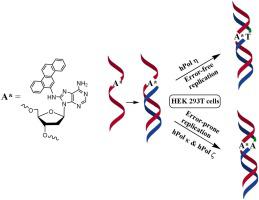DNA Repair ( IF 3.0 ) Pub Date : 2020-07-18 , DOI: 10.1016/j.dnarep.2020.102935 Brent V Powell 1 , Jan Henric T Bacurio 1 , Ashis K Basu 1

|
6-Nitrochrysene (6-NC) is a potent mutagen in bacteria and carcinogenic in animals. It is the most potent carcinogen ever tested in newborn mouse assay. DNA lesions resulting from 6-NC modification are likely to induce mutations if they are not removed by cellular defense pathways prior to DNA replication. Earlier studies showed that 6-NC-derived C8−2'-deoxyadenosine adduct, N-(dA-8-yl)-6-AC, is very slowly repaired in human cells. In this study, we have investigated replication of N-(dA-8-yl)-6-AC in human embryonic kidney (HEK 293T) cells and the roles of translesion synthesis (TLS) DNA polymerases in bypassing it. Replication of a plasmid containing a single site-specific N-(dA-8-yl)-6-AC adduct in HEK 293 T cells showed that human DNA polymerase (hPol) η and hPol κ played important roles in bypassing the adduct, since TLS efficiency was reduced to 26 % in the absence of these two polymerases compared to 83 % in polymerase-competent HEK 293T cells. The progeny from HEK 293T cells provided 12.7 % mutants predominantly containing A→T transversions. Mutation frequency (MF) was increased to 17.8 % in hPol η-deficient cells, whereas it was decreased to 3.3 % and 3.9 % when the adduct containing plasmid was replicated in hPol κ- and hPol ζ-deficient cells, respectively. The greatest reduction in MF by more than 90 % (to MF 1.2 %) was observed in hPol ζ-knockout cells in which hPol κ was knocked down. Taken together, these results suggest that hPol κ and hPol ζ are involved in the error-prone TLS of N-(dA-8-yl)-6-AC, while hPol η performs error-free bypass.
中文翻译:

人类细胞中 6-硝基衍生的 2'-脱氧腺苷加合物的转移合成。
6-Nitrochrysene (6-NC) 是一种有效的细菌诱变剂和动物致癌物。它是有史以来在新生小鼠试验中测试过的最强致癌物。如果 6-NC 修饰导致的 DNA 损伤没有在 DNA 复制之前通过细胞防御途径去除,则可能会诱发突变。早期的研究表明,6-NC 衍生的 C8-2'-脱氧腺苷加合物N -(dA-8-yl)-6-AC 在人体细胞中修复非常缓慢。在这项研究中,我们研究了N- (dA-8-yl)-6-AC 在人胚胎肾 (HEK 293T) 细胞中的复制以及跨损伤合成 (TLS) DNA 聚合酶在绕过它中的作用。包含单个位点特异性N的质粒的复制HEK 293 T 细胞中的 -(dA-8-yl)-6-AC 加合物表明人类 DNA 聚合酶 (hPol) η 和 hPol κ 在绕过加合物方面发挥了重要作用,因为在没有相比之下,这两种聚合酶在具有聚合酶活性的 HEK 293T 细胞中为 83%。HEK 293T 细胞的后代提供了 12.7% 的突变体,主要包含 A→T 颠换。在 hPol η 缺陷细胞中,突变频率 (MF) 增加到 17.8%,而当含有质粒的加合物在 hPol κ- 和 hPol ζ 缺陷细胞中复制时,它分别降低到 3.3% 和 3.9%。在 hPol κ 敲除的细胞中观察到 MF 的最大减少超过 90%(至 MF 1.2%),其中 hPol κ 被击倒。综上所述,这些结果表明 hPol κ 和 hPol ζ 参与了容易出错的 TLSN -(dA-8-yl)-6-AC,而 hPol η 执行无错误旁路。











































 京公网安备 11010802027423号
京公网安备 11010802027423号